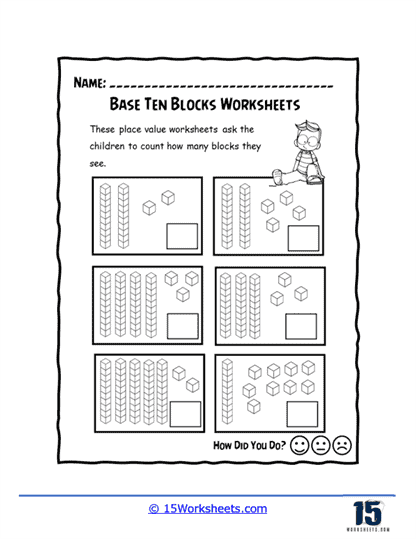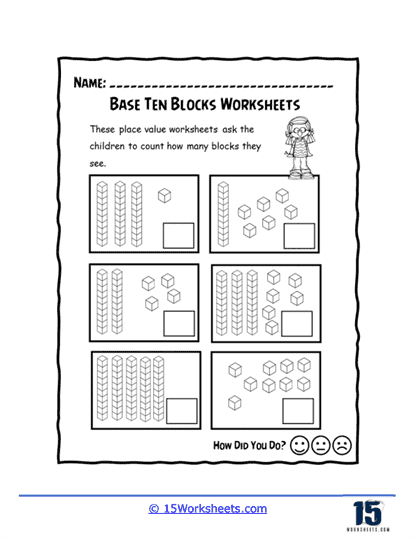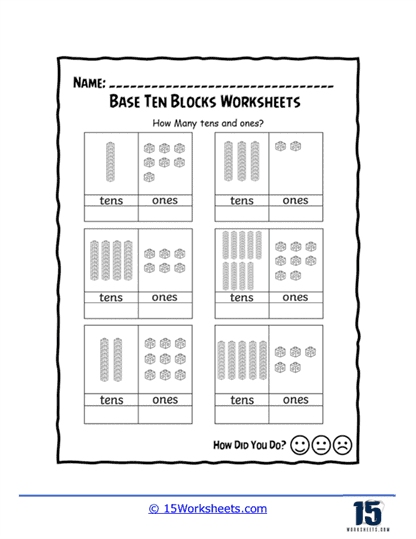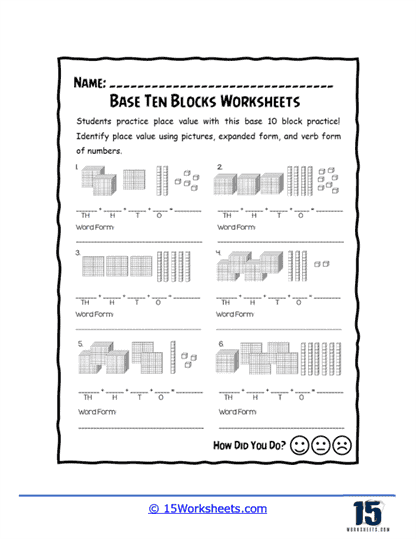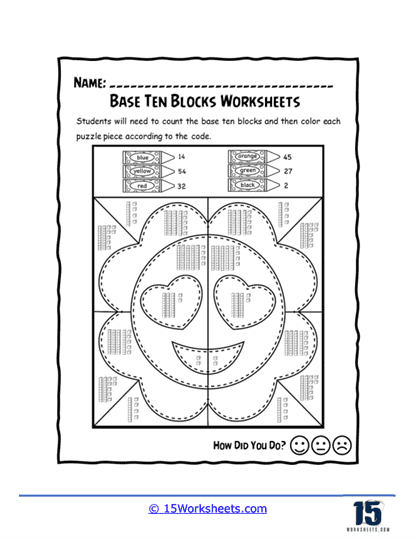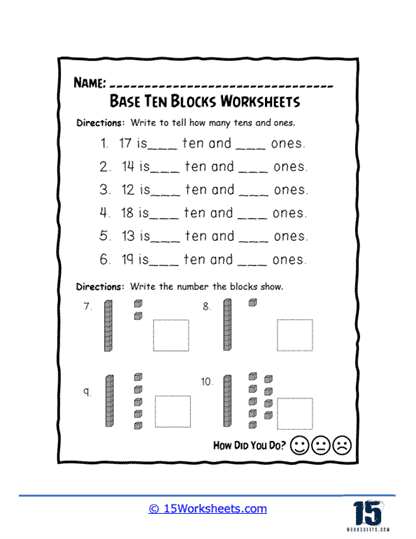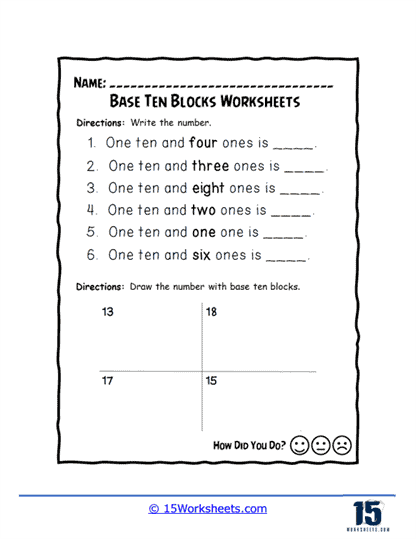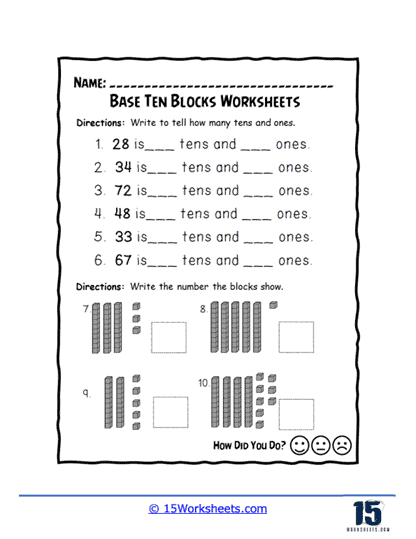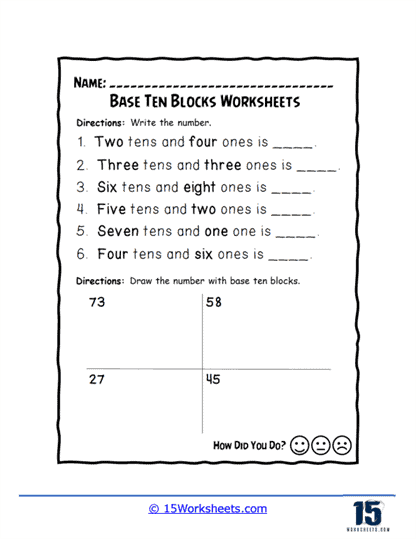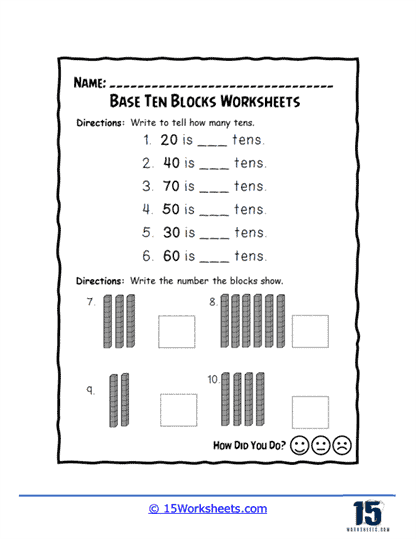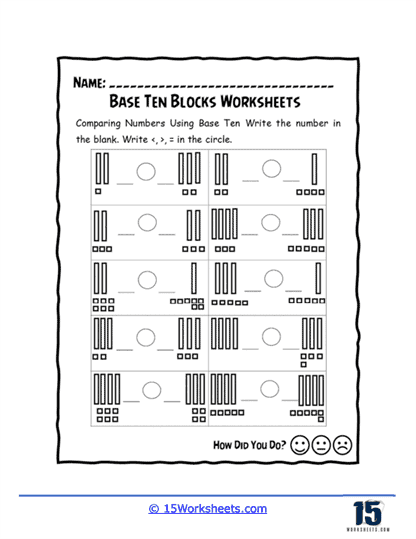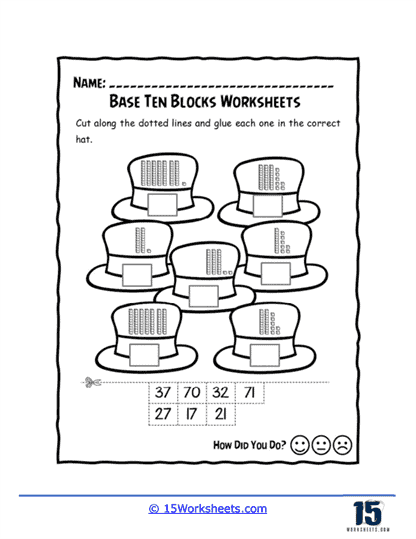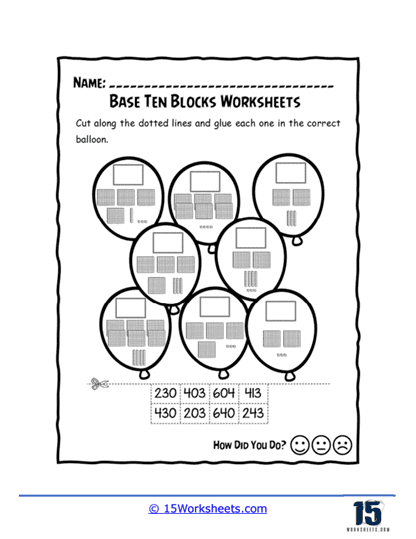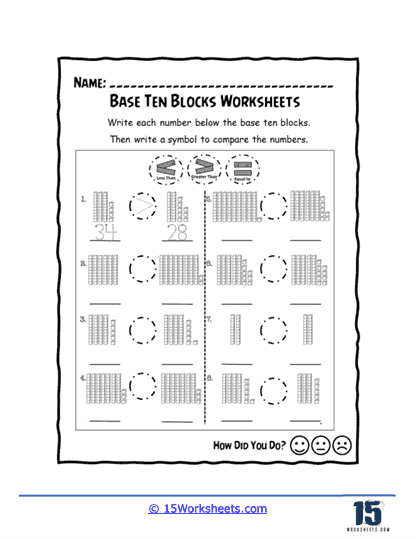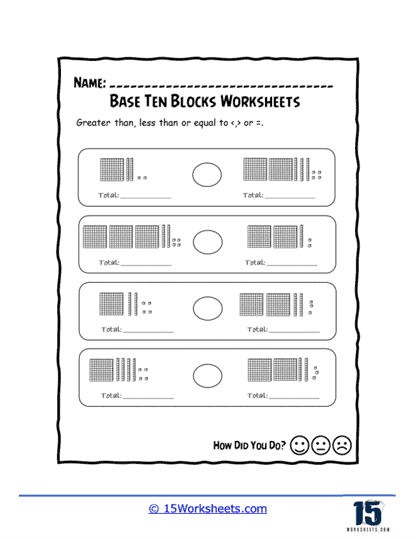Base Ten Blocks Worksheets
About These 15 Worksheets
Base Ten Blocks are more than just simple tools for elementary mathematics-they are visual keys that unlock a deeper understanding of the foundational concept of place value. For many students, math can feel like an abstract and intimidating subject, but when Base Ten Blocks are introduced, numbers start to come alive in a tangible and relatable way. These blocks offer a concrete representation of numerical relationships, making abstract mathematical principles much more accessible, especially for young learners.
Understanding place value is one of the most important building blocks of mathematics. Without a solid grasp of how numbers are structured and how each digit within a number holds a specific place and value, students can struggle with more complex operations later on, such as addition, subtraction, multiplication, and division. Place value is all about understanding the ‘position’ of a digit within a number and how that position determines its worth. Take the number 365, for example: the ‘3’ is not just a 3, but 300 because it occupies the hundreds place; the ‘6’ is not merely a 6, but 60 due to its place in the tens column; and the ‘5’ remains a 5, but its value is in the ones place. The power of place value lies in the relationship between these positions, each increasing by powers of ten.
This collection of worksheets will provide a hands-on way to explore these concepts. They come in four basic forms, each representing a specific place value. The smallest block is the unit or “ones block.” This tiny cube is the cornerstone of understanding-it represents a single unit, or 1. From there, we move up to the “ten rod,” a longer block that visually demonstrates the idea of grouping 10 units together to represent the number 10. This is where students first start to grasp the beauty of mathematical grouping and how individual units can come together to form larger quantities. Next comes the “hundred flat,” a larger square block made up of 100 units, or 10 ten rods. This block is especially useful for illustrating the jump between tens and hundreds, showing students how groups of ten expand to form hundreds. Finally, the largest piece, the “thousand block,” represents 1,000 and consists of 10 hundred flats stacked together.
This series serves a vital role in solving mathematical problems. Worksheets that incorporate these blocks are designed to reinforce the understanding of number value, making mathematical operations like addition, subtraction, multiplication, and division much more intuitive. These worksheets use the blocks to visually break down numbers, allowing students to see the individual components of a number and how they interact during an operation.
Take subtraction, for example. Let’s consider a problem where you need to subtract 352 from 400. Without Base Ten Blocks, the process might seem purely mechanical, something students do without fully understanding the “why” behind it. However, using the blocks, the concept becomes clear. You begin with four hundred flats to represent 400. Since you can’t subtract 50 directly from 0 in the tens place, you visually break down one of the hundred flats into 10 ten rods. This exchange shows students that 100 is simply 10 groups of 10, and now you can easily remove 5 of those ten rods to subtract 50. But the process doesn’t stop there-when it comes to subtracting the 2 units, you might find that you have no units left to subtract from. So, you break down one of your ten rods into 10 unit blocks, allowing you to remove the necessary 2 units.
This step-by-step process reveals the beauty and logic behind subtraction, transforming what could feel like a frustrating chore into a clear and understandable sequence of actions. Each time you “break down” or “exchange” a block, you’re reinforcing the fundamental concept that larger numbers can be decomposed into smaller, more manageable pieces. This tangible method of manipulation mirrors the way we work with numbers on paper, but it brings the process to life, making it easier for students to comprehend.
Beyond basic operations like addition and subtraction, Base Ten Blocks also have tremendous value when it comes to teaching more advanced concepts like multiplication, division, decimals, and even fractions. For multiplication, the blocks can be grouped and arranged to show how repeated addition works, while division becomes a process of breaking down larger blocks into smaller units, offering a visual and physical way to see the division process unfold. Decimals and fractions can also be explored using these tools by breaking down units into smaller and smaller parts, giving students an intuitive sense of how these numbers function as parts of a whole.
Incorporating Base Ten Blocks into daily math practice does more than just teach students how to perform operations-it builds a deep, conceptual understanding that students can carry with them throughout their academic journey. By using these tools, students move beyond rote memorization and start to see math as a system of relationships that they can manipulate and understand, rather than something that happens on a page, seemingly at random.
What Are Base Ten Blocks?
Base ten blocks are a set of manipulatives used in mathematics education to help students understand and visualize the base-10 number system. These blocks are particularly useful for teaching place value, addition, subtraction, multiplication, and division. Base ten blocks come in different sizes and shapes, each representing a different value based on the base-10 system. The most common types of base ten blocks are:
Unit Blocks – These are small cubes that represent the number 1. They are the basic building block of the set and are used to represent single-digit values.
Rods (or longs) – A rod is a rectangular block made up of 10 unit blocks placed in a row. It represents the number 10 and is used to illustrate the concept of tens.
Flats (or squares) – A flat is a square block made up of 10 rods arranged in a 10×10 grid. It represents the number 100 and is used to demonstrate the concept of hundreds.
Cubes (or thousands) – A cube is a large block made up of 10 flats stacked on top of each other, forming a 10x10x10 cube. It represents the number 1000 and is used to show the concept of thousands.
Base ten blocks are effective teaching tools because they allow students to physically manipulate the blocks, which aids in understanding abstract concepts. Some common activities using base ten blocks include:
Building Numbers – Students can use the blocks to represent numbers by combining the appropriate units, rods, flats, and cubes.
Comparing Numbers – Students can compare the sizes of numbers by comparing the collections of blocks they build.
Addition and Subtraction – Students can perform addition and subtraction by combining or taking away blocks, visually demonstrating the process.
Multiplication and Division – Students can use the blocks to understand multiplication as repeated addition and division as repeated subtraction or equal grouping.
How Can You Learn the Concept of Place Value From Base Ten Blocks?
Base ten blocks are excellent tools for teaching place value, as they provide a visual and tactile representation of the base-10 number system. To learn place value using base ten blocks, follow these steps:
Introduce the Blocks – Start by introducing the different types of base ten blocks to the students – unit blocks (1s), rods (10s), flats (100s), and cubes (1000s). Explain that each type of block represents a different place value in the base-10 system.
Build Numbers – Have students practice building different numbers using the base ten blocks. For example, to create the number 243, they would use 2 flats (100s), 4 rods (10s), and 3 unit blocks (1s). This activity helps students visualize the composition of numbers in terms of place values.
Compare Numbers – Encourage students to compare the sizes of different numbers by comparing the collections of blocks they build. This helps them understand that the position of each digit in a number determines its value.
Expand Numbers – Teach students to expand numbers into their place value components. For example, the number 243 can be expanded as 200 + 40 + 3. Using base ten blocks, students can see the relationship between the expanded form and the blocks used to build the number.
Regrouping – Teach students how to regroup blocks when adding or subtracting numbers. For example, when adding 28 and 37, they would first build the numbers using base ten blocks (2 rods and 8 units for 28, 3 rods and 7 units for 37) and then combine the blocks. They would notice that they have 15 units, which can be regrouped into 1 rod and 5 units. The final result would be 6 rods and 5 units, or 65.
Practice – Provide students with ample opportunities to practice building, comparing, and regrouping numbers using base ten blocks. Worksheets, games, and group activities can help reinforce the concept of place value.
By using base ten blocks to learn place value, students can develop a strong understanding of the base-10 number system and build a foundation for more advanced mathematical concepts.

